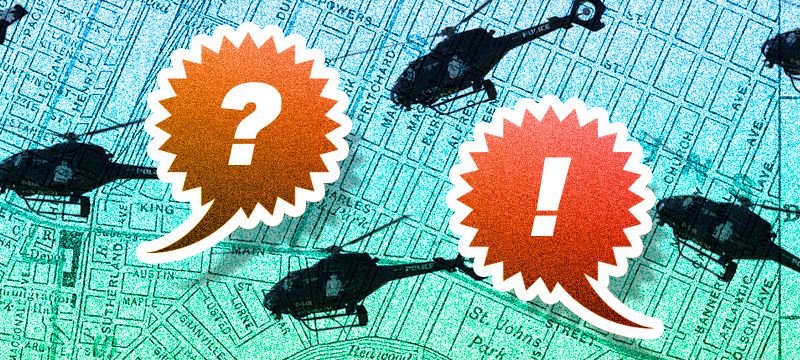“Forced awake by the terrorizing noise. It’s been every single night. There’s no rest. The police would never allow this in their own communities but they don’t even live here.” — Crescentwood Resident, R3M, 23 February 2021, 2:00am
It can happen on any given night if you live in or near Winnipeg’s downtown. You might be sitting down to watch a show, spending time with a loved one, or settling into bed (or trying to get your kids to do so). Seemingly out of nowhere, the Winnipeg Police Service’s helicopter arrives with a deafening roar: shaking houses, disturbing sleep, ruining a peaceful evening.
The police claim that the issue of noise complaints is “critical in terms of ensuring there is an adequate way to track and respond to issues from the citizens who are disturbed as a result of air operations” and that “there is a process in place to track all noise complaints.” Yet there is no formal and transparent process for filing noise complaints about the police helicopter.
The WPS has told community members who have complaints to call the airport’s noise complaint line. When people did that, they were told that the airport line doesn’t handle complaints for police and that people who have complaints should call 311. But when people called 311, they were told to call the police’s non-emergency line.
The WPS has said that it’s “not sure what’s happening to the noise complaints made to 311 or the airport,” but claimed they respond to “all legitimate complaints” from 311. Complaints are deemed “legitimate” if the date, time, and location provided match AIR1 flight records. However, they state these complaints do not affect the helicopter usage in any way.
In short, the helicopter is another example of the WPS’ lack of accountability and transparency—and highlights a deeply-rooted ethos of impunity.
Crowdsourcing community complaints
In February 2021, Winnipeg Police Cause Harm launched a report form to address this gap in transparency and provide a way for community members to register their experiences with the police helicopter when it flies over their neighbourhoods.
The map visualizes the data collected through the report form. Each submission is represented as a red dot on the map, randomly positioned within its postal code region to enhance anonymity. Tap on a submission to read how people are impacted by the police helicopter. The few pro-helicopter submissions we received are represented as dark blue circles.
The map also shows the distribution of police officer residences, represented by the shaded regions. Tap on a region to see how many WPS officers live there. Notice how most police officers do not live in areas most affected by the helicopter.
Is the helicopter disturbing you, too? Let us know.
- complaint
- pro-helicopter
- 2 151 WPS residences
